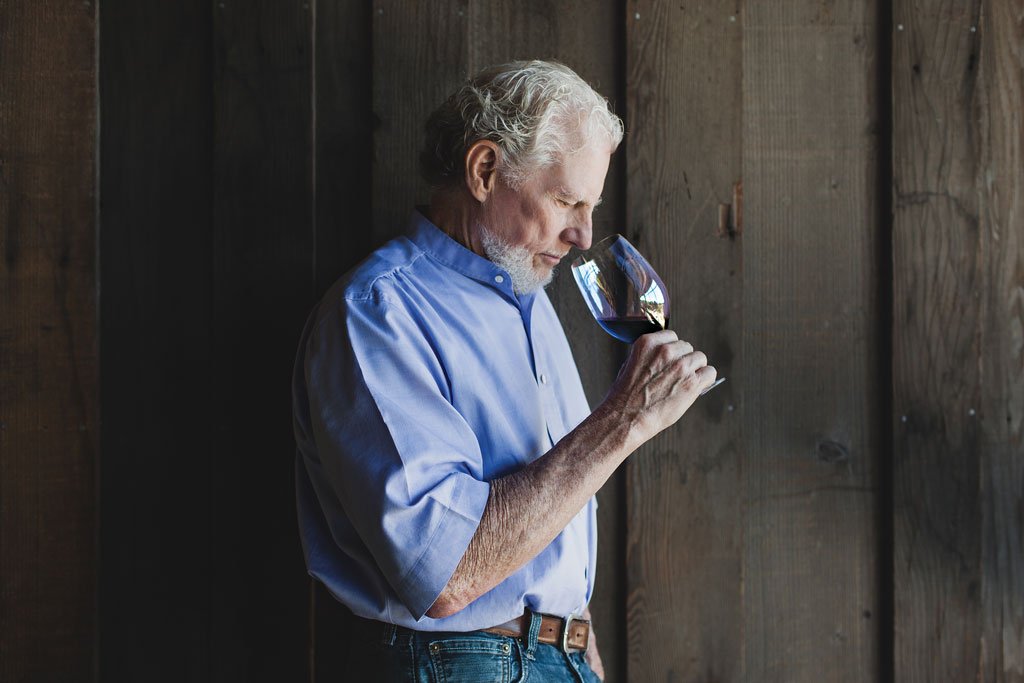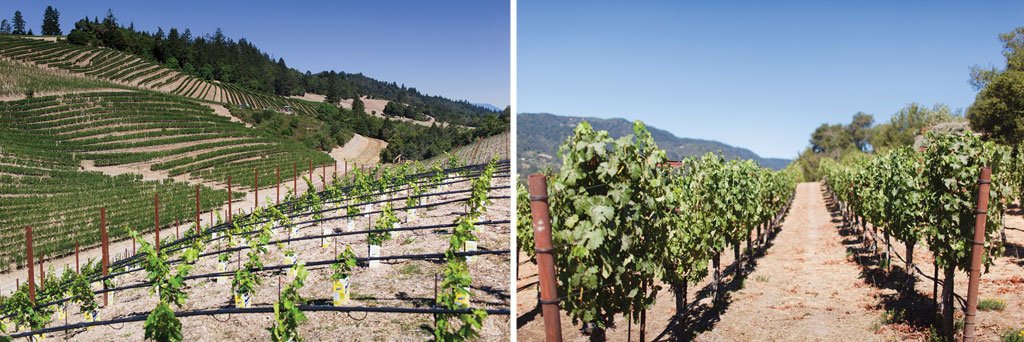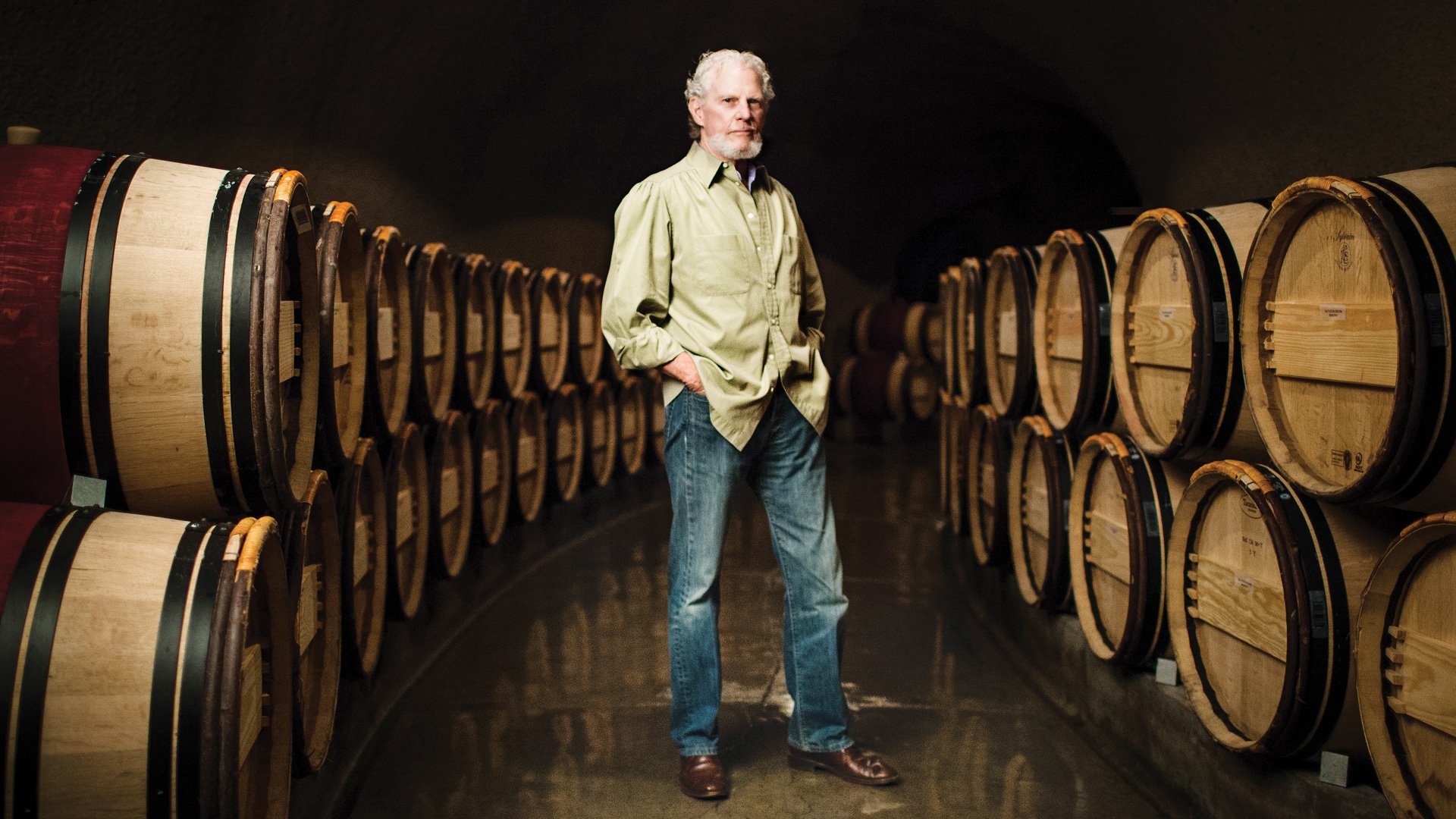If you drink wine, you probably know the crapshoot-like feeling of going to a restaurant and spending a handsome sum on a wine you haven’t yet tasted. Chances are, however, you didn’t spend $600,000 for it. That is what Lee and Penny Anderson, based in Naples, Florida, paid at this summer’s Auction Napa Valley for Promontory, the new cabernet-based wine by storied Napa winemaker Bill Harlan. “I might have gotten a little carried away,” says Lee Anderson, the owner of Minnesota-based holding company API Group. “But I take it for granted that the wine will be extraordinary.” Anderson isn’t the only one who thinks so. Promontory has set the wine world abuzz with anticipation—especially industry insiders, many of whom view Harlan as a successor to Napa legend Robert Mondavi and the man who will propel California wine forward in the 21st century.
To be accurate, the Andersons scored not one bottle, but “Case #1” of the first 10 vintages, 125 bottles in all. Still, at the time of their adrenaline-raising bid, the Andersons hadn’t actually tasted the wine. No one had—except for Harlan and his partners, along with their close circle of winemakers, and three wine critics, Robert M. Parker Jr., Stephen Tanzer and Antonio Galloni. They scored Promontory 97, 93+ and 94, respectively. Parker called Promontory “a magnificent Bordeaux-styled red offering up notes of burning embers, scorched earth…black fruits, loamy undertones of minerality and hints of camphor and background oak.”

The Andersons bought a dream and a promise,” Harlan told me recently. “But we wouldn’t have brought Promontory to market if we didn’t have it in the bottle.”
“Having it in the bottle” is Harlan slang for knowing that a wine is a success, and few winemakers make that judgment as consistently and correctly as he. His best known wine, Harlan Estate, has garnered five 100-point scores from Parker (for the vintages 1994, 1997, 2001, 2002 and 2007); at $800 to $900 a bottle retail, it is one of the most expensive and sought-after wines in the country. Another Harlan winery, Bond—$425 to $600 per bottle—consists of five estates whose wines have also garnered scores ranging from 90 to 100. The Napa Valley Reserve, a third Harlan winery success, operates as a private club; the wine isn’t available to the public (and is therefore not scored by critics), but more than 600 members have each paid a $150,000 initiation fee to join, affording them, among other privileges, the right to buy the wine. Harlan is also a founding partner in Meadowood, the Napa Valley Relais & Châteaux resort featuring one of California’s few Michelin three-star restaurants. Plus, he’s still involved in Pacific Union, the San Francisco real estate company he co-founded in the 1970s and reportedly built into a billion-dollar business before selling much of his stake to GMAC.
This roster of achievements is impressive by any standards, and perhaps particularly so for a man whose father worked in a slaughterhouse and whose mother didn’t finish high school. So it’s striking when Harlan, 74, says that he thinks Promontory will be his crowning achievement.
“Though I probably won’t even see the project realized before I die, Promontory has the potential to go beyond anything we’ve ever done,” he says.
Why a wealthy man with a string of lucrative businesses would start a new wine venture while in his 70s is a question pondered by many of Harlan’s friends and confidantes. When Harlan first told some of them of his plan for Promontory, “we were taken aback,” says Don Weaver, director of Harlan Estate. “Promontory would be a 30-year makeover at least, and we already had a lifetime of work in front of us with Harlan Estate and Bond. But Bill is never happy unless he’s building something. He’s all about challenge.”


Compared to most industries, the wine business takes the idea of “long-term” to a whole new level. Just acquiring arable land in Napa, with its restrictive environmental protection laws, can take years. Tack on at least another two years to design and build the vineyard infrastructure and plant the vines. Those vines will then need to grow for four years or more before the grapes are usable. Once made, the wine might spend two to four years aging in barrels and bottles; Promontory will spend five. Finally, when it’s theoretically ready for market, a perfectionist vintner such as Harlan will evaluate the wine. If it’s not, say, a likely 95 or higher on the Parker scale, Harlan won’t release it. In fact he might not release any of the first few vintages. “It’s at least 12 years to revenue, 20 years to profit,” Harlan admits. “And that’s if everything goes perfectly… which it usually doesn’t.”
Soft-spoken and athletically built, with a chiseled jaw, icy blue eyes and a mane of wavy white hair, Bill Harlan is the sort of man who looks like he just walked out of Atlas Shrugged. He first saw the land that would become Promontory in 1984 while hiking along a forested ridge above an isolated valley deep in the Mayacamas Mountains, on Napa Valley’s western border. Though as the crow flies the land was just 600 yards from Harlan Estate, it was almost inaccessible. Raggedly contoured, wholly covered by dense woodland and slashed by two volcanic fault lines, it was not exactly prime real estate. But a majestic promontory on the site spoke to Harlan—that, and the aroma. “When you stand on a piece of ground, it’s important what the air and sun smell and feel like,” he says. “When you are surrounded by woodland, there’s this primal smell of nature and the earth. You don’t get that near roads, near asphalt. That purity of nature is critical to the character of a great wine.”
Two years later, Harlan watched, disheartened, as the owner of the land put in the beginnings of a small vineyard. But Harlan, who as a young man at UC Berkeley earned spending money by winning poker games, and later hitchhiked his way across the United States, Europe and Africa, isn’t easily dissuaded. He continued his lone treks on the ridge. By 2000, having observed for years the land’s contours, elevations and the way the sun moved over it, he was convinced it could be the site of a world-class vineyard. And so he registered the name Promontory.

Eight years later, Harlan’s lawyer called with a tip: Part of the 860 acres might be up for sale. Harlan jumped at the opportunity. Along with silent partners Stan Krenke (owner of, among other things, the Denver Nuggets and St. Louis Rams) and Bruce Rauner, a candidate for governor of Illinois, he bought the first parcel, 480 acres. In 2013, he would acquire the rest. Though Harlan won’t disclose the price, prime vineyard land in Napa Valley sells on average for $225,000 to $300,000 per acre, while arable land (without an existing vineyard) goes for $25,000 to $175,000 per acre. The numbers get big fast.
Throughout these years, Harlan Estate and Bond were racking up success after success. Each vintage had (and has) long lists of hopeful buyers queued up just to get on the mailing list. But Harlan feared that the scale of his businesses wouldn’t be enough to carry his company forward for generations; it might not even sustain his son, Will, and daughter, Amanda, both of whom have entered the family business. “To last generations, you have to have the best and the brightest team,” Harlan explains. “And that team has to be grooming an entire younger team of the best and the brightest. To be able to afford two generations of top talent, we needed a critical mass of production.”
Harlan analyzed his model, the First Growths of Bordeaux, which were also increasingly his competition. The smallest First Growth, Château Haut-Brion, produces about 10,000 cases annually; its wines are in all the top global markets for fine wine. Ten-thousand cases, Harlan decided, was the minimum for sustainability. Harlan Estate’s production is 2,000 cases; Bond, 3,000. To get the 5,000 additional cases, Promontory—which would be made by Harlan’s winemaking team of Bob Levy and Cory Empting—was the answer.
Skeptics might have suggested that an entirely new brand, along with a new multimillion- dollar winery designed by renowned California architect Howard Backen, wouldn’t be necessary. Why not just use the Promontory vineyards to increase the production of Harlan Estate?
“A promontory is a perspective on the future,” Harlan says. “But a promontory is also a last frontier.
But Harlan couldn’t bring himself to do it. The Promontory land was cooler and higher in elevation than Harlan Estate, with greater elevation range (from 400 to 1,100 feet). The few hundred soil pits which Harlan had dug for research revealed fantastically diverse soils, including some that resulted from volcanic eruptions, some that were ancient seabeds and some that were caused by extreme heat and pressure from below the Earth’s surface. Harlan’s geology consultant, retired Stanford professor David Howell, determined that the promontory was—like the Rock of Gibraltar—a klippe, a craggy remnant that has become separated from the main portion of land due to the thrusting action of fault lines. In short, the land was raw, risky and untested.
For Harlan, that was part of the challenge. But he knew that Promontory grapes would create wine that tasted different than Harlan state; blending the two would forever change the estate wine’s flavor. Just as important, Harlan wanted to taste what the Promontory land could do. Its wine would be, he was convinced, a flavor unlike anything else. He began calling it the “missing shade of red.”
Bill Harlan never released the first three vintages of Harlan Estate, believing that they fell short of his standards. With Promontory, a tiny lot of 2008 will also remain in a gloomy underground cellar, untasted by the public, for its entire life.
But the 2009 vintage will be offered for sale next spring, even though as of summer, the wine still had no label and only an estimated price somewhere between those of Harlan Estate and Bond. “A promontory is a perspective on the future,” says Harlan. “But a promontory is also a last frontier. That’s what Promontory is for me.”








